
John XXIII
On April 27, Pope John XXIII (Pope from 1958 to 1963) will become St. John XXIII, alongside Pope John Paul II, who will become St. John Paul II. But who was John really, and what was his greatest triumph?
This version appeared in the April 2014 issue of Inside the Vatican magazine. To read an extended version of this article, click here.
It was a remarkable moment. Only three times in the last 900 years has the Roman Catholic Church elevated a Pope to sainthood. On July 5, 2013, Pope Francis made the decision to approve sainthood for two of his predecessors, Pope John Paul II and Pope John XXIII. The formal ceremony of elevation is scheduled to take place on Divine Mercy Sunday, April 27, 2014. In order to be named a saint, two miracles must be proven. Pope Francis approved sainthood even though the Vatican was unable to determine a second miracle which could be attributed to John. Vatican spokesman Rev. Federico Lombardi explained that the move to approve the canonization was made “despite the absence of a second miracle. It was the Pope’s will that the sainthood of the great Pope of the Second Vatican Council be recognized.”
There was, in fact, a second miracle that occurred during John’s papacy. That miracle was his decision to completely reframe the relationship between Catholics and Jews.
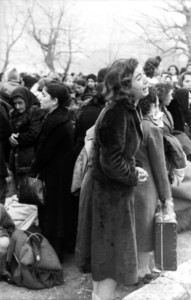
A scene of Jews in Greece being deported.
Called “the good Pope,” the relationship between John and the Jews is an incredible story of the triumph of truth and justice that needs to be told and remembered.
When John was elected in 1958, he was called by the press a “caretaker Pope.” When he died in 1963, Cardinal Giovanni Battista Montini, who was to succeed him as Pope Paul VI, hailed him as “an incomparable Pope.”
Angelo Giuseppe Roncalli was born on November 25, 1881. In later life he was to recall, “I come from a poor family.” His father, John, was a tenant farmer in Sotto il Monte, a small village in the foothills of the Italian Alps. “Angelino,” as he was called, was the third of 13 children. At the age of 12 he went on to high school. From there he went on to Lateran University in Rome to complete his college studies. On August 10, 1904, he was ordained a priest at the Church of Santa Maria in Monte Santo, a suburb of Rome. The next day he celebrated his first Mass in St. Peter’s Basilica. On December 10, 1920, he was named by Pope Benedict XV as director of the Institution for the Propagation of the Faith. In 1925, he was consecrated a bishop and was sent with the title Apostolic Visitor to Bulgaria. In 1935, he was transferred from Sofia to Ankara as Apostolic Vicar and Delegate to Turkey. He also served as Apostolic Delegate to Greece.
Roncalli and the Holocaust
During the tragic years of what we now know as the Holocaust, Roncalli rose to heroic heights. It is particularly fitting that he will be proclaimed a Saint on Yom Ha Shoah, the day of Holocaust remembrance established on a fixed date each year by the State of Israel.
The Encyclopedia Judaica states that “during the German occupation of Greece he (Roncalli) helped the local population and did his utmost to prevent the deportation of Greek Jews, interceded with King Boris III of Bulgaria on behalf of the Bulgarian Jews and with the Turkish government of behalf of the Jewish refugees, who reached that country, and aided individual Jews and Jewish groups in Slovakia, Yugoslavia, Hungary, Italy and France.”
Chaim Barlas, head of the Jewish Agency’s Rescue Committee in Turkey, was to play a vital role during those tragic days. Barlas was born in Lithuania in 1898. He served as Director of the Jewish Agency office in Warsaw from 1919 to 1925. He was to serve as the Jewish Agency representative in Geneva in the critical years of 1939 and 1940. From 1940 to 1945 he was the emissary to Turkey. It was in that capacity that he approached Roncalli, in 1942, to intervene on behalf of the Jews in Bratislava, Slovakia. According to Barlas, Roncalli replied, “So will it be, and if God helps me, we shall get it done!” Barlas reported that Roncalli spoke these words with deep emotion. When Barlas received confirmation via Switzerland that no more deportations had taken place, he hurried to Roncalli to thank him for his help. Roncalli said that he already knew about what he called “this happy turn of events.”
Barlas described their first meeting saying “…I realized that I stood before a man of lofty spiritual stature, who was truly interested in the sufferings that had befallen our people and who was prepared heart and soul to assist in whatever way he could. Whenever during my interviews he would hear of the news from Poland, Hungary and Slovakia, he would clasp his hands in prayers, tears flowing from his eyes.”
A year later, in 1943, Adolf Eichmann reactivated the deportation. Again Roncalli intervened. He wrote a letter directly to Slovakian President Joseph Tiso, who was himself a priest. “From various places the Holy See is requested to intervene on behalf of the people belonging to the Jewish race, against whom grave measures are being carried out. The Holy See, animated by sentiments of humanity and Christian charity which knows no distinctions of origin, nationality or race, cannot remain indifferent to these appeals. The Holy See anxiously implores the Slovak government… to assume an attitude consonant with the Catholic principles and sentiments of its nation.” For a brief time, the deportations were stopped. On May 22, 1943, Barlas wrote to his superiors in the Jewish Agency, “I am very happy to be able to inform you that according to reports received from Bratislava, the deportations of Jews have been suspended for the time being, as a result of the intervention of the Holy See.”
In 1966, journalist Arthur Morse wrote about those events. “When Barlas told Monsignor Roncalli of the impatient German demand for the destruction of the Jews in Sofia, the priest reacted with horror and indignation. He had served as Apostolic Delegate to Bulgaria and had developed a warm friendship with King Boris and the Queen. Now he assured Barlas that he would take immediate action, and began writing a message while Barlas was still in his presence. Later, Roncalli wrote to Barlas confirming that his message had been delivered.” Morse continued his account saying, “Barlas, who now lives in Israel, does not know the details of Roncalli’s intervention, but new information has been provided by Luigi Bresciani, a confidential servant to Roncalli in both Bulgaria and Turkey. Bresciani, today a sculptor in Bergamo, Italy, recalls the Monsignor’s agitation after the Barlas visit: ‘When Monsignor Roncalli found out about this, he immediately wrote a personal letter to King Boris. I had never before seen Monsignor Roncalli so disturbed. Before I carried this missive to a certain person able to put it personally into the hands of King Boris, Monsignor Roncalli read it to me. Even though calm and gentle as a Saint Francis de Sales come to life, he did not spare himself from saying openly that King Boris should on no account agree to that dishonorable action… threatening him among other things with the punishment of God.” The observation by Morse concluded, “Monsignor Roncalli’s intervention came soon after the Jews of Sofia had been dispersed in the Bulgarian countryside, where they remained unharmed. King Boris died under mysterious circumstances in August 1943 and the safety of the Jews once again was in jeopardy. However, revocation of the anti-Semitic legislation one year later assuaged these fears.” Tragically, exactly one year later, at the end of August 1944, following the revolt that broke out in Slovakia, the Germans occupied the country and deported all of the remaining Jews to their deaths.
Confirming Roncalli’s intervention, historian Saul Friedlander described the actions of Roncalli with these words: “He spared no effort to succor the Jews of Central Europe.” Friedlander confirms that “the Zionist archives contain numerous documents concerning the unceasing activities of Nuncio Roncalli in favor of the Jews.” On March 25, 1944, Barlas wrote to Roncalli, “Your Excellency, I was very much touched by your reception today and by the most humane sentiments toward our unhappy people which you are showing in these fateful moments.”
On April 10, 1944, two Slovakian Jews, Rudolf Verba and Alfred Wetzler, escaped from Auschwitz. Late in May they wrote a report which described the gassing of 1,450,000 Jews and ended with the tragically prophetic words, “Auschwitz is now being prepared for Hungarian Jewry.” A copy of these hand-written pages reached Barlas, who brought them straight to Roncalli. Two days later, Cardinal Francis Spellman passed through Istanbul on his way home to New York. Roncalli instructed Barlas to write a letter describing the desperate situation, which he would give to Spellman. The letter, dated May 16, 1944, describes the situation in painful, candid detail. It read in part, “I am taking the opportunity of Your Eminence’s visit to Istanbul to submit to you a brief… which shows that the policy of extermination of Jews in Europe is being continued relentlessly. In several countries like Austria, the Czech Protectorate and Yugoslavia, the Jews have been almost eliminated. In the main they have been sent to concentration camps in Poland, specially appropriated for Jews. In three such places, Belsec, Sobibor and Treblinka, they are brought to so-called ‘extermination institutes’ where they are cremated after arrival. The number of Jewish victims in Poland, including those imported from other countries, reaches, according to official Polish figures, almost 3 million. It is our humble request that the Holy See should proclaim horror and condemnation of these atrocities.”
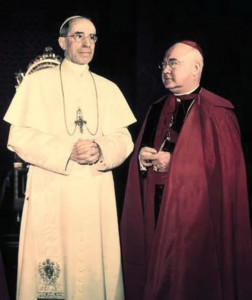
Pope Pius XII with the American cardinal Spellman.
Roncalli prepared Spellman for the shocking news and arranged a meeting with Barlas. The next day Roncalli arranged a meeting with the US Ambassador to Turkey, Lawrence Steinhart. Barlas recounted that Roncalli confirmed that Steinhart had “undertaken to take urgent action on the highest level.”
On June 26, 1944, President Franklin D. Roosevelt, in a sharp note forwarded through the Swiss legation in Budapest, called upon the Hungarian government to cease deportations of Jews at once, threatening reprisals if his pleas were ignored. But Roosevelt’s note was ignored.
On March 23, 1944, Roncalli informed Barlas, “I have referred Chief Rabbi Herzog’s request for the intervention of the Holy Father in favor of Transylvania deportees, and the Vatican at once replied that the Nunciature at Bucharest has been charged with dealing with this important matter, and that a favorable solution might be expected.”

Chief Rabbi Herzog
Barlas described in most moving terms Roncalli’s reaction to news of an Aktion against the Jews. “He rose in angry amazement and said in a whisper: ‘Good Lord! Is it possible? Lord in Heaven, help us!’ And he rushed to his desk, opened the typewriter and wrote a long message on a cable form. Calling his attendant to have it delivered at once, he said, ‘Let us pray that this will save us.’” Barlas later reflected, “I do not know whether Roncalli’s intervention brought safety to Bulgarian Jewry, but I could not help admire the man and his selfless readiness to help at all times.”
The German ambassador to Turkey was the one-time German Chancellor and Vice Chancellor, Franz Von Papen. He met with Roncalli and made the argument that the Roman Catholic Church and Germany had a common enemy, the godless, atheistic Soviet Union. He urged Roncalli to go to Pope Pius and urge him to have the Church join with Germany in the battle against the Communists. Roncalli responded sharply, “And what shall I tell the Holy Father about the Jews who have died in Germany and Poland at the hands of your countrymen?”
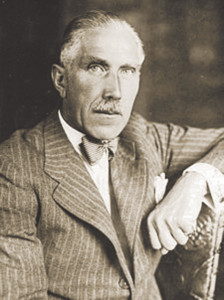
The German statesman Franz Von Papen.
When Ira Hirschmann, a special emissary for the United States War Refugee Board, met with Roncalli in 1944, he told him of the plight of several thousand Jews, including a number of children, slated for deportation to Auschwitz and certain death. Instantly, Hirschmann recalled, Roncalli made available thousands of “baptismal certificates without conditions.” The distribution of these certificates was later named “Operation Baptism.” Roncalli made clear that this action to save Jews did not make a single Jew a Catholic. Roncalli was simply moved to take immediate action to save the lives of Jews.
Arthur Morse stated in an interview after his book was published in 1966 that the action taken by Roncalli resulted in the rescue of at least 50,000 Jews in Hungary.
The Chief Rabbi of Israel, Itzahak Halevi Herzog, observed years later that “Cardinal Roncalli is a man who really loves the People of the Book, and through him thousands of Jews were rescued.”
Barlas summed it all up when he wrote, “Much blood and ink have been spilled in the Jewish tragedy of those years, but to the few heroic deeds which were performed to rescue Jews belong the activities of the Apostolic Delegate, Monsignor Roncalli, who worked indefatigably on their behalf.”
His colleague Richard Cardinal Cushing was to remember that Cardinal Roncalli “was able to use his diplomatic skills to help countless Jewish refugees escape the Nazis and seek safe haven in Palestine.” Johannes Cardinal Willebrands explained years later that “as apostolic delegate to Turkey and Bulgaria, he was able to grasp the real meaning of the ‘transportation to the east’ of the Jews, and personally did everything in his power to save Jewish lives.” John never forgot what he witnessed during those tragic years.
In December 1944, Roncalli was appointed nuncio to France. The city of Paris had only recently been liberated from the German occupation. There was a wonderful moment of tenderness, which soon became the talk of Paris. At a diplomatic reception he became engaged in a deep discussion with the Chief Rabbi of Paris. As they moved their discussion into the dining room, the Rabbi stepped back and said, “After you, Excellency.” Roncalli replied, urging the Rabbi to go first, “No, no… The Old Testament must go before the New.”
With the end of the war, Roncalli continued in his labor for the Church. On January 12, 1953 he was elevated by Pope Pius XII to Cardinal and was named Patriarch of Venice.
On October 9, 1958 Pope Pius died. On Saturday afternoon, October 25, 1958, 51 Cardinals began their 78th conclave to elect a new Pope.
On Tuesday afternoon, October 28, on the first afternoon ballot, the 11th of the conclave, Cardinal Angelo Roncalli received 38 votes and accepted the election shortly before 5 in the afternoon. “I tremble and am afraid. My poorness and littleness fills me with confusion. But I see in the votes of my eminent brother Cardinals the sign of the will of God. Therefore I accept the election. I bow my head and bend my back to the Cross.”
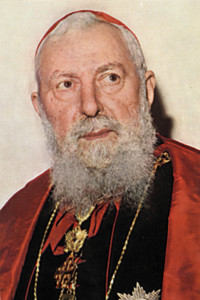
Cardinal Tisserant
Cardinal Tisserant, Dean of the College of Cardinals, asked him, “By what name shall you be called?”
“I will call myself John,” he declared, speaking in Italian rather than the Latin of protocol. He went on to explain, “This name is dear to me because it is the name of my father. It is the name of the patron saint of the humble parish where I was baptized… and all who bore that name had a brief pontificate.”
In the words of one distinguished scholar of the papacy, “Brief it would be indeed, but momentous.” Cardinal Roncalli’s formal coronation as Pope John XXIII, or as it is known today, the solemn ceremony of the inauguration of his pontificate, took place on November 4, 1958.
Pope John and the Jews
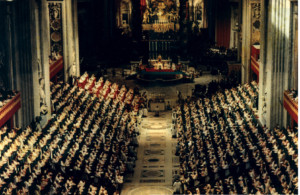
An image from the Second Vatican Council (1962-65).
Pope John was determined to address the issues surrounding the relationship between the Catholics and Jews. Early in his pontificate, John was being driven through the streets of Rome. He suddenly instructed his driver to stop the car in front of the main synagogue. It was Saturday, the Sabbath of the Jews. John had his car stopped so that he could bless the Jews of Rome as they were leaving Sabbath worship.
Cardinal Koenig, a close confidante of John’s, explained, “As Apostolic Delegate in the Near East, John XXIII had come to know the distress and the mortal anguish of the Jews fleeing their persecutors… He felt an urgent desire to set against the immeasurable and bottomless hate of those days a lasting word of love.”
On January 25, 1959, John issued his call for the Second Vatican Council. On September 18, 1960, he charged the Commissions and the Secretariat to prepare for the Vatican Council a declaration on the attitude of the Church toward the Jews. In preparation for that charge, John began a series of steps that opened the way for truly dramatic changes in the relationship between the Church and the Jews.
On Good Friday, March 27, 1959, John took an important first step in changing that relationship. In the words of Cardinal Augustin Bea, “it was on that day, during the solemn liturgy, that he had read out the order to omit the adjective ‘perfidious’ from the customary prayer for the Jews. Although to modern ears, this adjective has a pejorative ring, in the Medieval Latin of the time of the prayers composition it simply meant ‘unbelieving.’ This gesture excited Jewish public opinion and raised high hopes.’
It may have been the force of habit, or perhaps it was forgetfulness, but in April 1963, the bishop who celebrated the Good Friday liturgy in Rome’s St. Peter’s Basilica recited the old text, “pro perfidies Judaeis.” Pope John quietly halted the service and had the celebrant start from the beginning of the intercessory prayers.
In September 1959, Pope John addressed liturgical points that he viewed as contributing to negative feelings about Jews. A Catholic ritual of baptism contained the following formula of abjuration: “Abhor Jewish unbelief (in Christ) and reject the Hebrew error (that the Messiah has not yet come).” The Pope ordered that those words be purged from the baptismal prayer.
The Israeli diplomat and author, Pinchas Lapide, recounted the following example in his book Three Popes and the Jews. “In 1925, Pius XI had added the following petition to the Act of Consecration of the human race to the Sacred Heart of Jesus: ‘Look with Thine eyes of mercy upon the children of that stock, so long Thy Chosen People; may the blood called upon them of old, now descend on them as the waters of redemption and life.’ This petition, animated by the best of intentions, had turned out to be self-frustrating in practice, since to the half-hearted listener, it implied that the Jewish people as a whole, and not a small, frantic crowd of a few hundred, gathered before Pilate’s palace, had once shouted: ‘His blood be upon us and upon our children’ (Matt. 27:25). Proof of this contention was found in over a hundred different prayer books, all of which translated the key passage wrongly as: ‘Of old they called down upon themselves the blood of the Savior.’ To avoid that the prayer bring pain instead of solace, bitterness instead of brotherhood, Pope John had the entire prayer expunged in September 1959.”
On January 18, 1960, Pope John met with a group from the B’nai B’rith, an international Jewish fraternal order. He was particularly moved to address them about an outbreak of swastika desecrations that had occurred in Europe. John spoke these words: “You are of the Old Testament and I of the New Testament, but I hope and pray that we will come closer to the brotherhood of humanity… It gives me great pain and sorrow to see these recent events which not only violate a natural right of human beings but destroy the understanding between brothers under God…”
Yet another moment of tremendous importance took place in October 1960. A United Jewish Appeal group consisting of more than 100 was received by Pope John at the Vatican. The group, traveling through Europe and Israel, stopped in Rome. Greeting the group with outstretched arms he embraced them with the words, “We are all sons of the same Heavenly Father. Among us there must ever be the brightness of love and its practice. I am Joseph your brother.” The words uttered by Pope John conveyed the great warmth and sympathy that he held for the Jewish people.
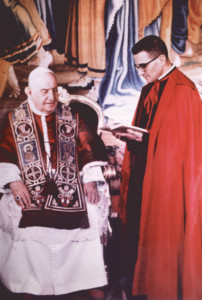
John XXIII with his personal secretary, Loris Capovilla.
For Jews throughout the world, his direct and heartfelt words were viewed as a turning point in the relations between Catholics and Jews. Monsignor John Oesterreicher offered the following observation about the greeting offered by Pope John. “He knew, of course, that there was an inevitable tension between the beliefs of Christians and those of Jews; at the same time he was convinced that this division ought not to degenerate into hostility. Hence he added to his greeting this reflection: ‘There is a great difference between the one who accepts only the Old Testament and the one who joins to the Old the New as the highest law and teaching. These differences, however, do not extinguish the brotherhood that springs from a common origin (of Christians and Jews). We are indeed all children of the same heavenly Father and the light and work of love must always shine among us all. Signatum est super nos lumen vultus tui, Domine! The light of Your countenance, O Lord, is signed upon us!’” (Psalm 4:7)
In 1961, Pope John began the process of moving the Church toward addressing the issues surrounding the Holocaust. The German bishops met in June under the leadership of Joseph Cardinal Frings, Archbishop of Cologne from 1942 to 1965. He served as the Chairman of the German Bishops from 1945 to 1965. Frings was described as “a fierce opponent of Hitler and Nazism.” He denounced the destruction of the Jews as “himmelschreiendes Unrecht” (a crime that cries out to heaven). With John’s full cooperation and participation, a prayer was prepared to be said by German Catholics. For the first time both the murder of the Jews, as well as those who were their persecutors, would be publicly acknowledged.
The prayer was said by all German Catholics on the Sunday after the Feast of the Sacred Heart of Jesus. The text was a powerful reflection of John’s concern about the need to confront the Holocaust. “Lord, God of our Fathers! God of Abraham, Isaac and Jacob! God of mercy and God of solace! We confess before you: Countless men were murdered in our midst, because they belonged to the people from whom the Messiah rose up in the flesh. We pray Thee: Lead all among us who became guilty through deed, omission, or silence, that we may see the wrong and turn from it. In the spirit of heartfelt atonement, we beg for forgiveness for the sins which were committed by our fellow citizens. We beseech that the spirit of peace and reconciliation return to all homes and we pray for the peace of Israel among the nations; on the borders of its state and in our midst…”
Time Magazine Vatican correspondent Robert Blair Kaiser recounted yet another story of Pope John and his sensitivity to Jews. The story was told to Kaiser by Msgr. Loris Capovilla, Pope John’s private secretary. “A young Jewish lad made the acquaintance of Giuseppe Roncalli when he was the Cardinal-Archbishop of Venice. The young man wanted to become a Catholic, but Roncalli kept putting him off. ‘Look,” he said, ‘you’re a Jew. Be a good Jew. Becoming a Catholic will kill your parents.’ The young man persisted and Roncalli finally said he could be baptized — in secret. Several years later (in 1961) after his parents had died, he presented himself at the Vatican to see his old mentor, now the Pope. He wanted the Pope to give him the Sacrament of Confirmation. ‘All right, all right,’ said Pope John XXIII, ‘but you have got to continue to be a good Jew, in your own community, go to the synagogue, support the Jewish schul, because, by being a Catholic, you do not become any less a Jew.”
Pope John felt a special connection to the Land of Israel. He visited the Holy Land twice. The first time was September 19 to October 22, 1906. He traveled with his superior, Bishop Radini-Tedeschi. Serving as the bishop’s secretary for 10 years, he became known as the “bishop’s shadow.” The trip, the Third Italian National Pilgrimage to the Holy Land, was led by Bishop Radini. During that memorable trip, Roncalli wrote a series of articles for the newspaper L’Eco di Bergamo. His account of his visit to the Sea of Galilee, which occurred at the beginning of October, early in the morning, was very special. He wrote this moving depiction in his dispatch to the newspaper: “…I shall never forget the enchantment, the heart’s ease, and the spiritual flavor I discovered this morning floating upon these waters. Little by little, as our small boat stood out into the lake, the first light of dawn gave color to the water, the houses and the surrounding hills. We did not speak, but our hearts were stirred. It was as though we could see Jesus crossing the lake in Peter’s boat. Jesus was before us and we could see him: unworthy though we were, we sailed toward him on the water, and our prayers were silent, but spontaneous and eloquent… As we touched the shore the sun appeared.” It was an unforgettable moment in the life of the man who was to become Pope.
Even as the clouds of war were beginning to gather in Europe, John traveled to the Holy Land for a second time in 1939. He went first to Beirut, arriving on June 1. There he attended the Eucharistic Congress presided over by Cardinal Eugene Tisserant. From Beirut he traveled to Jerusalem, Jaffa, Homs and Aleppo. His visit was brief, lasting from June 7 to 10.
Israel responded with genuine enthusiasm to the elevation of John to the Throne of St. Peter. As Pinchas Lapide wrote, “Hours after the news of the papal election reached Jerusalem on October 18, 1958, Israel’s President Yitzhak Ben Zvi dispatched to the new pontiff, both in his own name and in the name of all Israel, a message of cordial greetings in which he expressed the hope that ‘his reign may witness humanity enjoying the peace between men and nations which has been the vision of the Prophets.’ A message of goodwill was also sent by the Chief Rabbi of Israel. Pope John sent two replies. He officially informed Israel’s Head of State (Ben Zvi) of his election, and he later thanked President Ben Zvi for his kind wishes. For the first time in history, Christ’s Vicar wrote to the successor of King David — in elegant Latin, and the Jewish reply came back in biblical Hebrew. The coronation ceremony was attended by Israeli Ambassador Eliahu Sasson, who was appointed for the occasion to be ‘Special Delegate of the Government of Israel.’”
On June 8, 1959, Archbishop Georges Hakim, the head of the Greek Catholic community in Israel, had a private audience with Pope John. In a press interview given in August after his return to Israel, Hakim stated, “His Holiness was keenly interested in the situation in Israel on which he was very well informed. He evinced much sympathy with the Jewish people and especially with those living in Israel. He recalled with pleasure that he had been able to help many Jews during World War II. He also emphasized his good relations with Israeli diplomats, and expressed the hope that relations between the Vatican and Israel would soon be improved.”
In a discussion with Maurice Fisher, a member of the Israeli diplomatic corps, Pope John expressed his sentiments clearly. “If I were permitted to listen to my heart, I would recognize the State of Israel here and now.” On March 27, 1963, Rabbi Abraham Joshua Heschel and Rabbi Marc Tanenbaum, both leaders in the dialogue between Catholics and Jews, met with Cardinal Bea in Boston. They were joined by Cardinal Willebrands and Father Schmidt, two close associates in the budding ecumenical movement. Bea was very cautious and expressed the hope that the meeting with the group would remain confidential lest the “bitter enemies of the Jews in Rome” use it against their efforts. Bea stunned his guests by asking a question; what would they think if the Vatican recognized the State of Israel? The surprised Rabbis responded that Jews all around the world would be thrilled at such a move. The death of John three months later was to put that hope on hold for another 30 years. Vatican recognition was finally granted in 1993.
Pope John Proceeds to Prepare for Vatican II
The thought that an Ecumenical Council should be convened was the vision and the dream of Pope John. To execute his plan, John needed an associate in whom to place his complete trust. On December 19, 1959, Pope John named Augustin Bea a cardinal. He was immediately assigned by the Pope to be the first President of the Secretariat for the Promotion of Christian Unity, a position he held until his death in 1968. Bea recalled: “Pope John XXIII received me in audience on September 18, 1960, and charged the Secretariat for Christian Unity with the task of preparing a Declaration dealing with the Jewish people.”
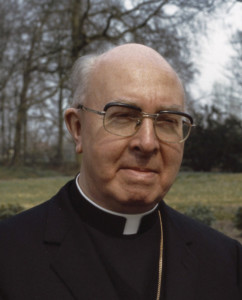
Cardinal Willebrands
Cardinal Bea offered these insights into the complexities that he confronted. “The subsequent history of the Declaration was notable because of great difficulties, not all of which were theological, for some were partly due to the unhappy political circumstances of our time. It was these very difficulties which made it essential for the document to be a very carefully balanced statement. They also served, bit by bit, to give it the greater breadth it now has as a result of its extension to include the attitude of the Church toward non-Christian religions in general and to place the Jewish problem in the wider context. The first of these difficulties arose in June 1962 when the first schema, dealing only with the Jews and hammered out by the secretariat in the course of many long sessions, was included in the agenda of the Central Preparatory Commission of the Council. Unfortunately, at this precise moment, news came through that certain Jewish organizations were to be represented in Rome in connection with the Ecumenical Council and this produced some vociferous protests on the part of the Arabs. It was, therefore, considered prudent to allay anxiety by removing the schema on the Jews from the agenda of the Council. At this stage, the President of the Secretariat again approached Pope John XXIII who sent to the Council a personal note which included the following comment: ‘Having carefully examined Cardinal Bea’s report, we unreservedly associate ourselves with the burden and responsibility of a concern which we must make our own.’” Bea added a notation that the note from Pope John was dated December 13, 1962.
Jews and Christians agree that a pivotal moment in the history of the Church and the Jews occurred on June 12, 1960, when Jules Isaac met Pope John XXIII. Isaac was a Jewish Frenchman who was born in 1877 and died in 1963. He was described by the author Darcy O’Brien with eloquent simplicity. “Before World War II, Jules Isaac was known to every French student as the author of the standard history textbooks — admired for their clarity, liveliness of style and erudition — that were used in all secondary schools. During the 1930s, he was chief inspector of history teaching at the Ministry of Education, a position that in France carried great prestige and power. In essence, he was the keeper of the flame of La Civilisation Française. He was alarmed by the spread of fascism and anti-Semitism in Europe, but he later conceded that at the outbreak of the war, he saw only the end of democracy. He did not foresee what would happen to the Jews or even suspect that many of his countrymen would become compliant with the Nazis and aid in the betrayal of French Jews and their deportation to Auschwitz. In the middle of the war, he began research into the origins of anti-Semitism and understood that Hitler’s pogrom was the culmination of a long history of Christians hating Jews. When the Germans occupied France, Isaac was removed from his post by the Vichy government. It was his first personal experience with anti-Semitism, and it caused him to intensify serious work on a manuscript he entitled Jesus and Israel. ‘I viewed my work as a fight for wounded Israel,’ he later said, ‘for brotherhood against hatred. I had a task to fulfill. It was a sacred mission.’ In 1943, while he was away from his home… his wife, daughter and son-in-law and several other relatives were arrested. Before Madame Isaac was shipped away with the others to Auschwitz, she managed to get this message to her husband: ‘Save yourself for your work: the world is waiting for it.’”
Isaac’s biographer and associate in his work, Claire Huchet-Bishop, concluded that “from then on, this final message from his wife governed Jules Isaac’s life.” In 1947, Isaac completed his work and turned over the 600-page manuscript dealing with the questions surrounding Jesus and the people of Israel to his publisher. In the pages of his master work, Isaacs compared line by line the actual texts of the Gospels with widely established and accepted Catholic and Protestant commentaries… It was his goal to prove that distortions were responsible for laying the foundation of hate, vituperation and intolerance that had plagued relations between Catho
lics and Jews through the centuries. More than that, he wanted those interpretative texts to be permanently removed and corrected texts to be used in the process of teaching and understanding the New Testament. As he completed his labors, Isaac dedicated his monumental work with these affecting words:
IN MEMORIAM
To my wife and my daughter
Martyrs
Killed by Hitler’s Nazis
Killed
Simply because their name was
ISAAC

Angelo Roncalli as nuncio in France in the late 1940s.
Isaac had met previously with Pope Pius XII. On June 13, 1960, he met with Pope John. Claire Huchet-Bishop worked for 13 years as Isaac’s collaborator. She was responsible for the English language editions of The Teaching of Contempt (1964) and Jesus and Israel (1971), and served as Chair of the International Council of Christians and Jews. In June 1974 she recalled a conversation with Isaac about his feelings as he prepared for what was to be his historic meeting with Pope John. “Would we have had the beginning of a new era without the decisive meeting of Professor Isaac with John XXIII in 1960? It was my privilege to hear about that memorable private audience from Jules Isaac himself, as we sat in his lovely garden at Aix-en-Provence. He told me: ‘As I waited in the anteroom of the Pope’s private library, where the audience was to be held, I felt weighed down by my responsibility. How to convey to the Pope, within a few minutes, nearly 2,000 years of Jewish suffering at Christian hands? I felt all the martyrs of the past ages present in that room, and also the six million victims of Hitler.’ The victims, as you know, included Isaac’s wife, daughter and son-in-law.”
Three months after his meeting with Isaac, on September 16, 1960, Pope John met with Cardinal Bea and charged him with the task of preparing the declaration dealing with the Church and the Jews. The work of Jules Isaac had a profound impact on the decision to proceed in a firm fashion. In preparation for his meeting with Pope John, Isaac had met with three powerful Cardinals, all close to John. He had met with Cardinals Tisserant, Ottaviani and Bea. Isaac carefully prepared a memorandum to be presented to Pope John. He suggested that a commission be established to study the relations between the Church and the Jewish people. At the time of his meeting with Pope John, the Pope responded immediately saying, “I thought of that myself from the beginning of this meeting.” Isaac recalled, “While I was expounding my ideas, he showed comprehension and sympathy.” As their meeting ended, Isaac asked Pope John if he could nourish any hope that positive action might result from their meeting. According to Isaac the Pope responded, “You have a right to more than hope. I am the head, but I must consult the proper authorities and have the proper department study the question. This is not an absolute monarchy.” After the audience, Isaac called the office of Cardinal Bea to report on his meeting with Pope John. Six months after the audience, the office of Cardinal Bea asked Msgr. Capovilla if it would be possible to have further clarification on that historic audience. On March 12, 1966, the following notes were made available. The notes were based on the recollections of Cardinal Bea and Msgr. Capovilla:
Pope John received Jules Isaac in an audience on June 13, 1960. The audience had also been suggested by the French Embassy at the Holy See. We wanted to give the audience a special quality, but Pope John changed it to a private one. I do not think that L’Osservatore Romano published the event. I remember well that the Pope was exceedingly impressed by that encounter and spoke about it to me at length. He told me that he would speak to Cardinal Tardini and to Msgr. Dell’ Acqua in particular. Even to me he said that he had directed Isaac to Cardinal Bea in whom he had much trust and in whom he could confide.
It is possible that Cardinal Tardini’s notes preserve segments of the meeting and of the conversation with Pope John.
And it is true that up to that day it had not entered John’s mind that the Council should also take up the Hebrew and anti-Semitism question. But from that day on, he was engrossed in this problem. We have to exonerate the Church from the accusation of having kept itself apart and of having only defended the baptized Jews (as it seems Isaac insisted). And to proclaim once and for all that Christians do not have the right to as a key condemnation ‘sanguis eius super nos’… That is all that I remember.
Cardinal Bea later observed that “it is and will remain John the XXIII’s great merit that he realized this touchy problem and understood its great significance. It was he, who with great personal conviction removed from the liturgy of Good Friday, the expression pro perfidies Judaeis, source of much misunderstanding. Going further, he gave personal approval to the task of preparing for the Council an appropriate draft. When, in one of his more decisive moments about this question, I had given him my opinion on such a draft, I received, a few days later, a precious note, written in his own hand, in which he stated, ‘I have read with great attention Cardinal Bea’s report, and I agree perfectly about the gravity and responsibility of our approach.’ It is, therefore, to John the XXIII to whom we must first be thankful in a large measure, if this draft was presented to the Council.” (The source cited for this memorandum is Civ. Catt, 1964 II 219-220.)
On November 28, 1965, a vote was taken on the proposed declaration Nostra Aetate by the delegates assembled at the Council.
Total votes: 2,312
Yes: 2,221
No: 98
With reservations: 2
Not voting: 1
This action went a long way in beginning the process of healing what Cardinal Bea described as “a 2,000-year-old problem, as old as Christianity itself.” Bea went on to point out that this problem “became much more acute, particularly in view of the ruthless policy of extermination inflicted upon millions of Jews by the Nazi regime in Germany. And so it has attracted the attention of the Second Vatican Council.”
Two key points were made in the Declaration adopted by the Council: (1) What happened in His (Christ’s) passion cannot be charged against all Jews, without distinction, then alive, nor against Jews today; (2) Although the Church is the new people of God, the Jews should not be represented as rejected by God or accursed, as if this followed from the Holy Scriptures.
Cardinal Willibrands affirmed that “the last months of Pope John’s life were of vital importance for the fate of Nostra Aetate. In fact, in February 1963 the Secretariat for Christian Unity in its plenary meeting took up the theme of the Jews, according to the disposition given by the Pope on December 13, 1962, with a view to the elaboration of a conciliar document. If we recall that the proposal to set forth such a document had earlier been removed from the Council’s schedule and was reintroduced only after this decisive intervention of the Pope, then we can understand why John XXIII has been so rightly described as ‘doubly father’ of Nostra Aetate.”
Pope John became ill in 1963. On his deathbed John said: “I give my life for the Council, for the Church and peace.” He died on June 3, l963 at 7:49 p.m. On the night of his death, the Chief Rabbi of Rome, Elias Toaff, and other members of the Jewish community gathered with hundreds of thousands of Catholics in St. Peter’s square to mourn the loss of John.
On June 12, 1963, Time Magazine correspondent Robert Blair Kaiser, who covered Pope John’s pontificate, revealed some of his insights about John and the significance of his life and death.
“As he lay dying on the last day of May, 1963, Angelo Giuseppe Roncalli, the 262nd Pope of Rome, received his Roman Cardinals… It was as if he were going on a journey and would not see his friends and associates for a while… He called for Viaticum (last Holy Communion means Christ with you on the way — a via tecum) and soon he was off.
“But not before he told many he was offering his life for a good outcome of the Ecumenical Council and for peace among men, which was, in effect, his dying wish. To the last he was quietly insistent on his basic vision. Intuitive, not always well expressed, perverted sometimes by those around him, it came across nevertheless in the Second Vatican Ecumenical Council and in the hopeful love for all men of goodwill that was expressed in Pacem in Terris. With no ambiguity now at the end, with the lucidity of a dying man, he repeated and repeated his wish, that the great work would be crowned with success.
“Pope John’s private secretary, Monsignor Loris Capovilla, told me one day not long ago, ‘The Holy Father is only planting a seed, you know. He knows that somebody else will reap the harvest.’ Somebody will indeed: the Church and the world John loved.” —Kaiser
Rabbi Arthur Gilbert summed up the unprecedented outpouring of affection of Jews for Pope John saying, “Certainly no Pope had communicated as clear and consistent an attitude of friendship toward the Jewish people and Judaism in all of history as Pope John XXIII.”
In a touching tribute, Rabbi Murray Rothman summed up the feeling of Jews throughout the world when he said, “May his memory be a blessing. His life surely was.”
Zalman Shazar, the President of Israel, offered these words of tribute to Pope John: “The life of the great pontiff was sanctified and devoted to the development of mutual comprehension between all peoples of the world and to overall peace.”
The people of Israel understood that a great friend had passed from the scene.
In his eulogy for Pope John, his successor on the throne of St. Peter, Pope Paul VI declared, “Death cannot still the spirit which he has infused into our era. Can we turn away from the path he has infused into our era? Can we turn away from the path so masterfully traveled? It seems we cannot.”
John Rothmann is a radio talk show host in San Francisco, California, and a foreign policy consultant specializing in the United States, the Middle East and the former Soviet Union.

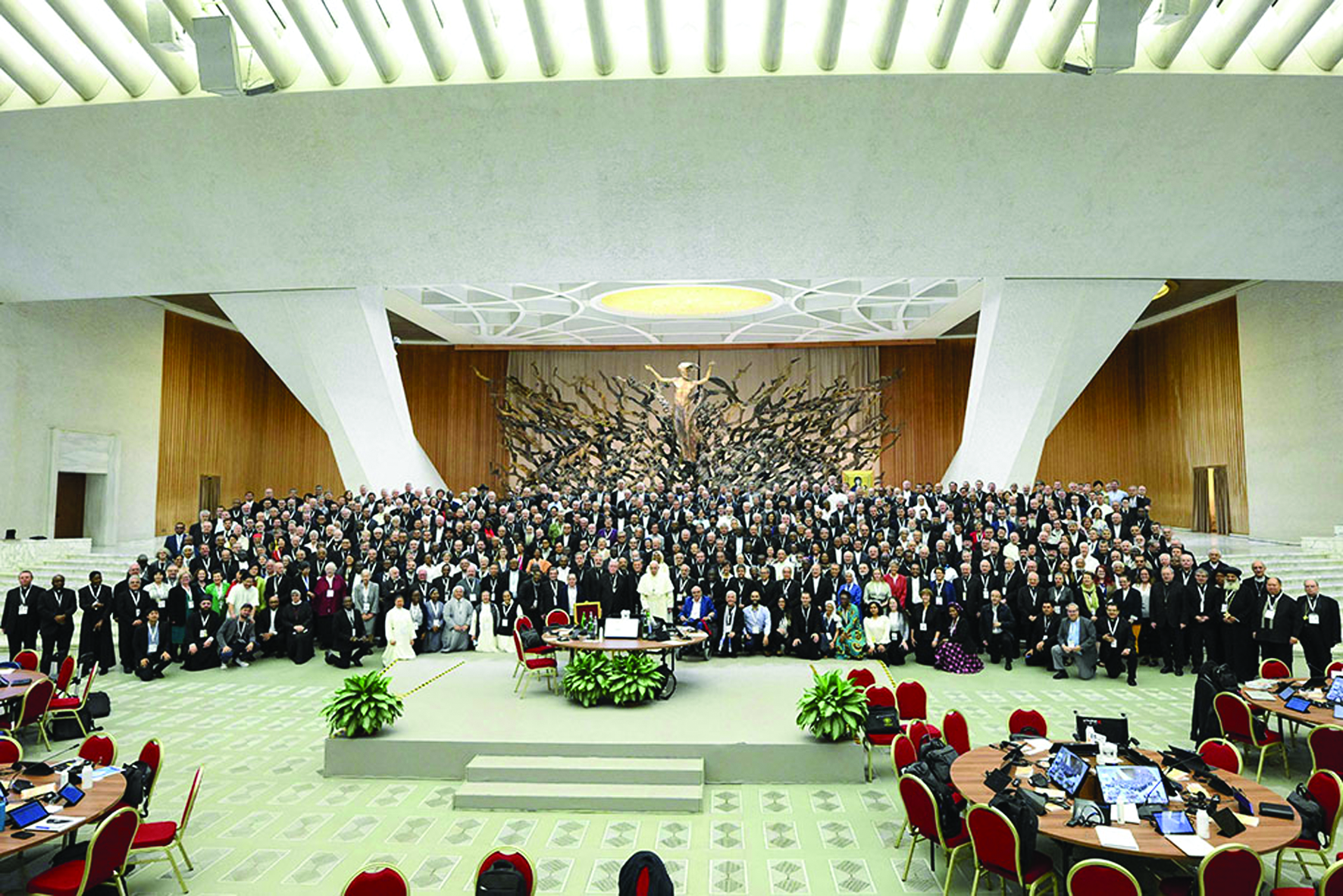
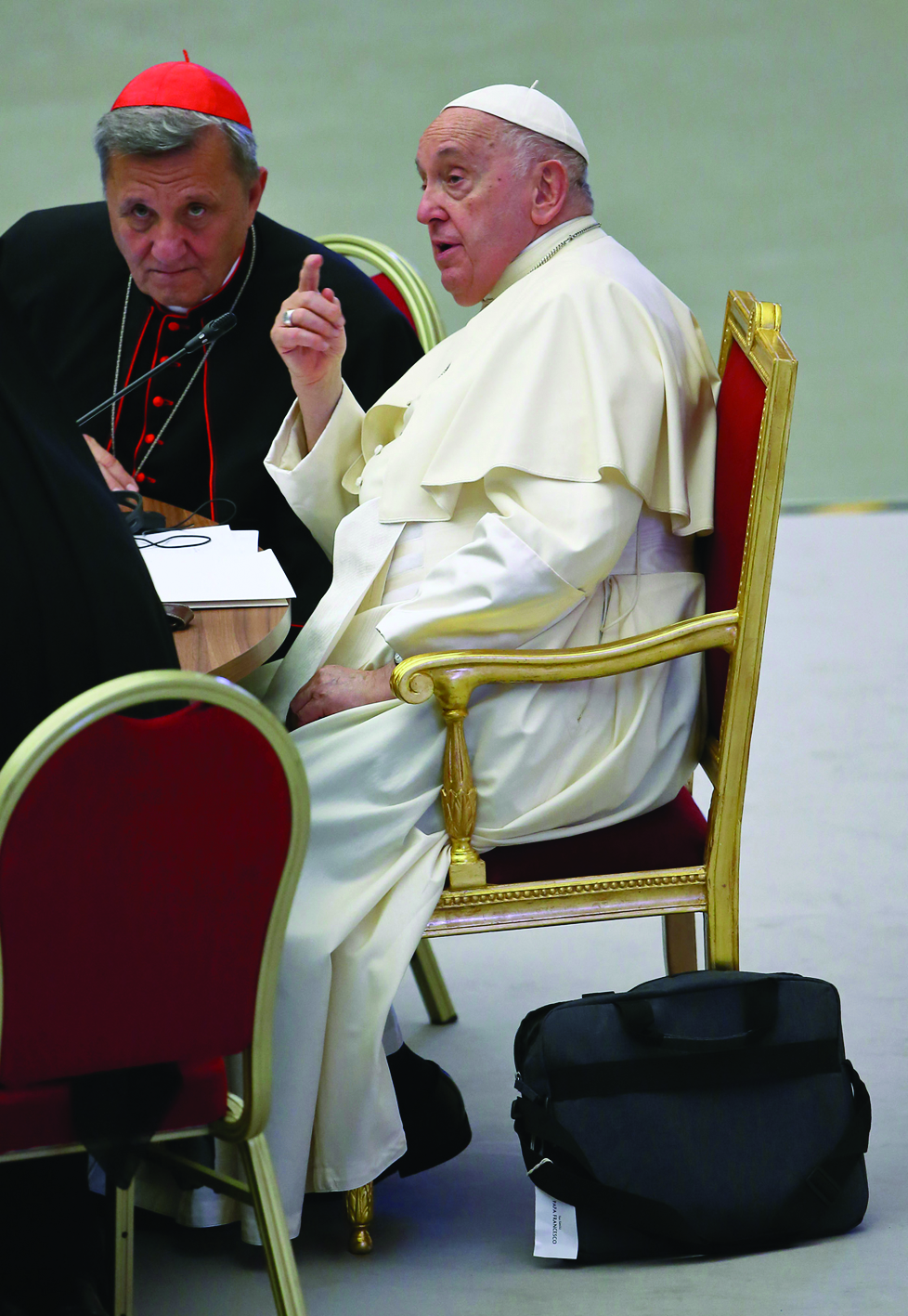
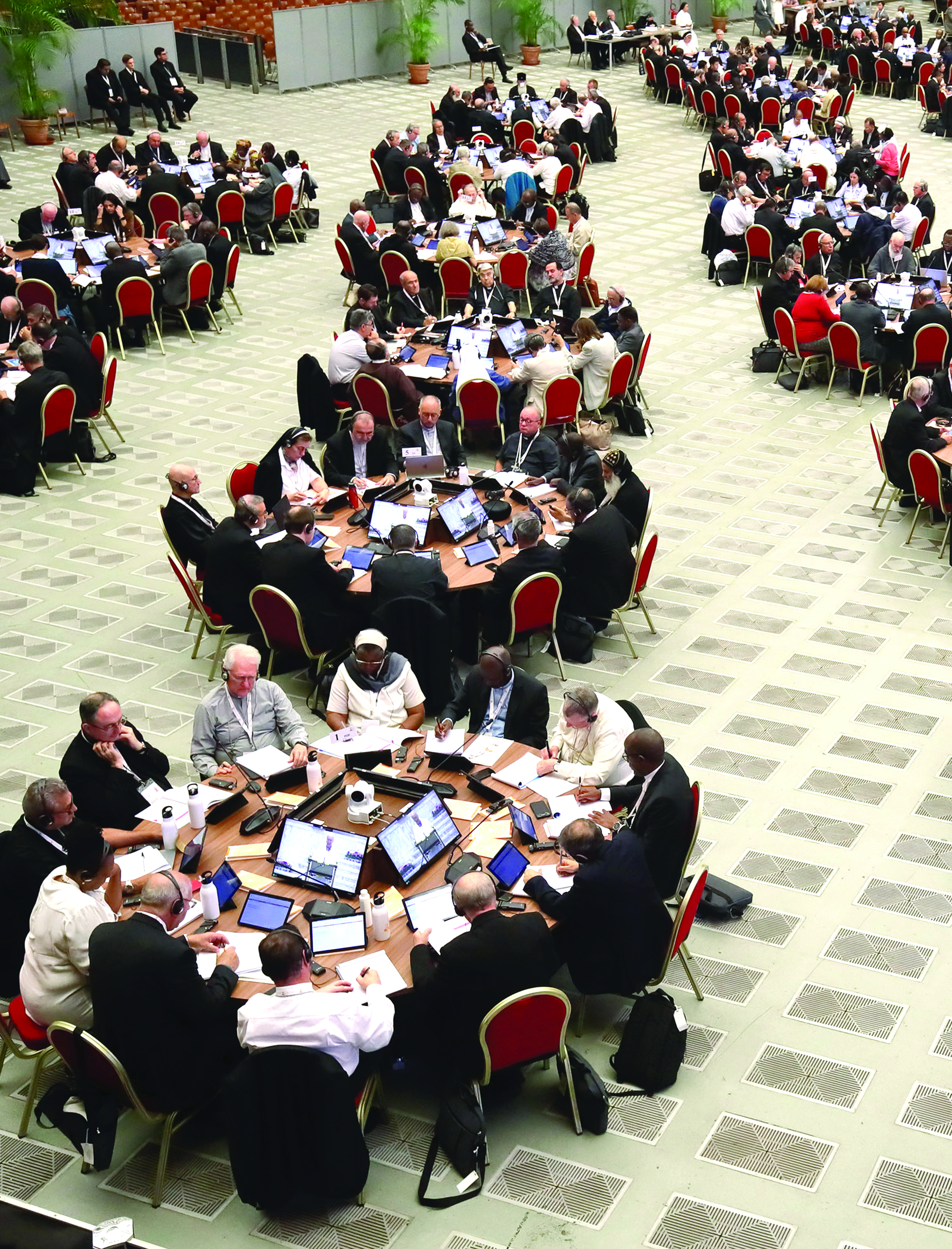
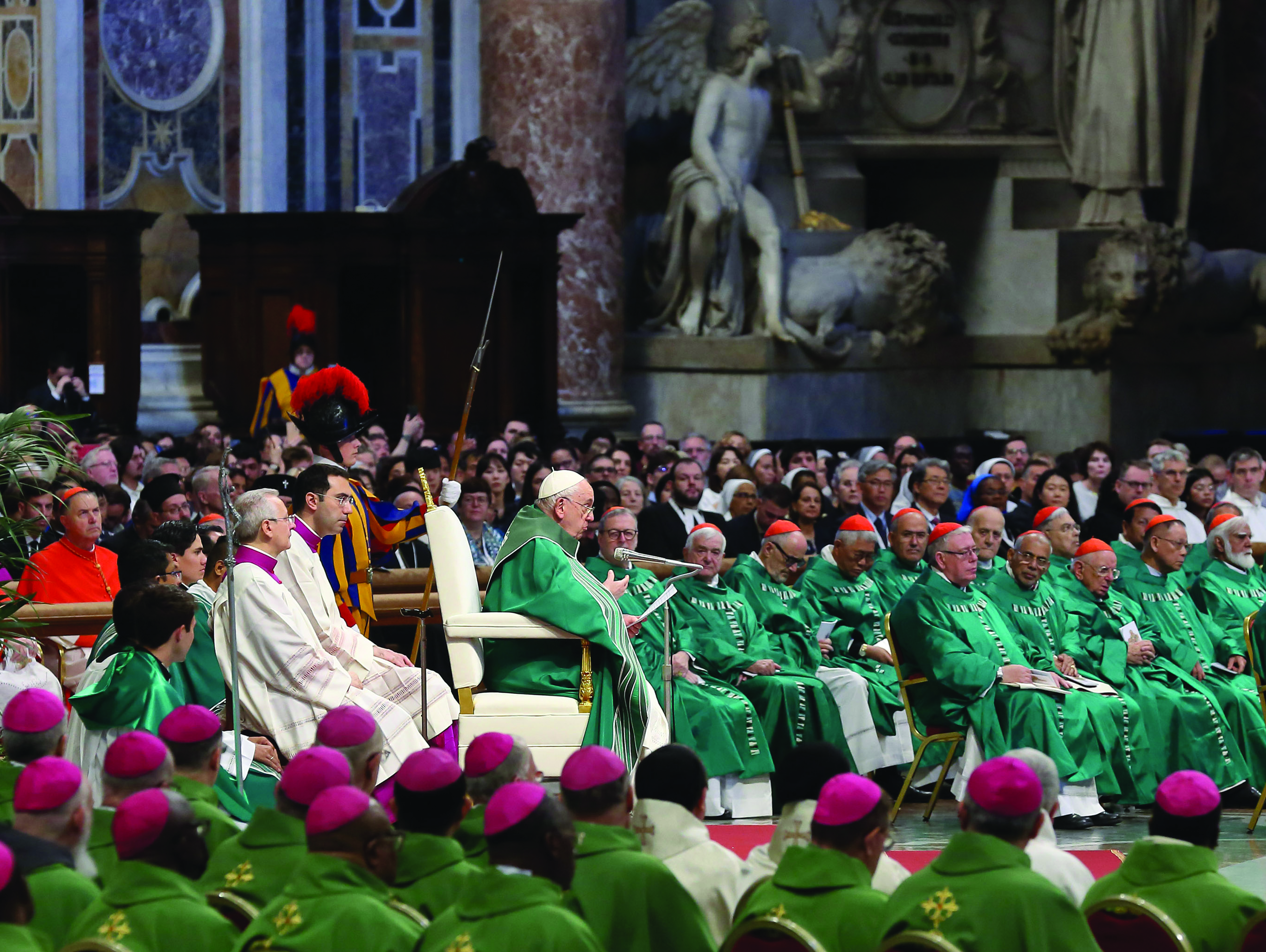
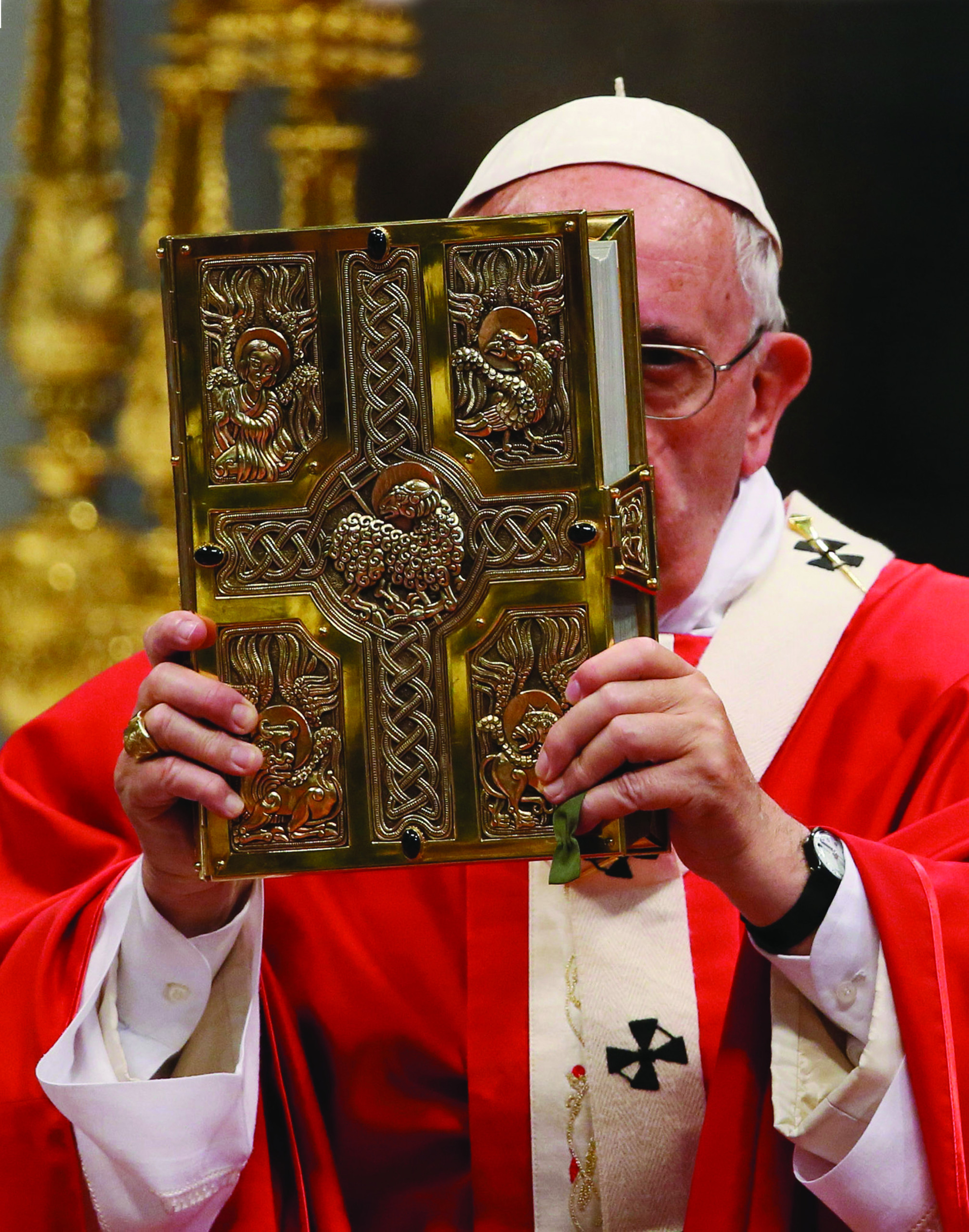
Facebook Comments